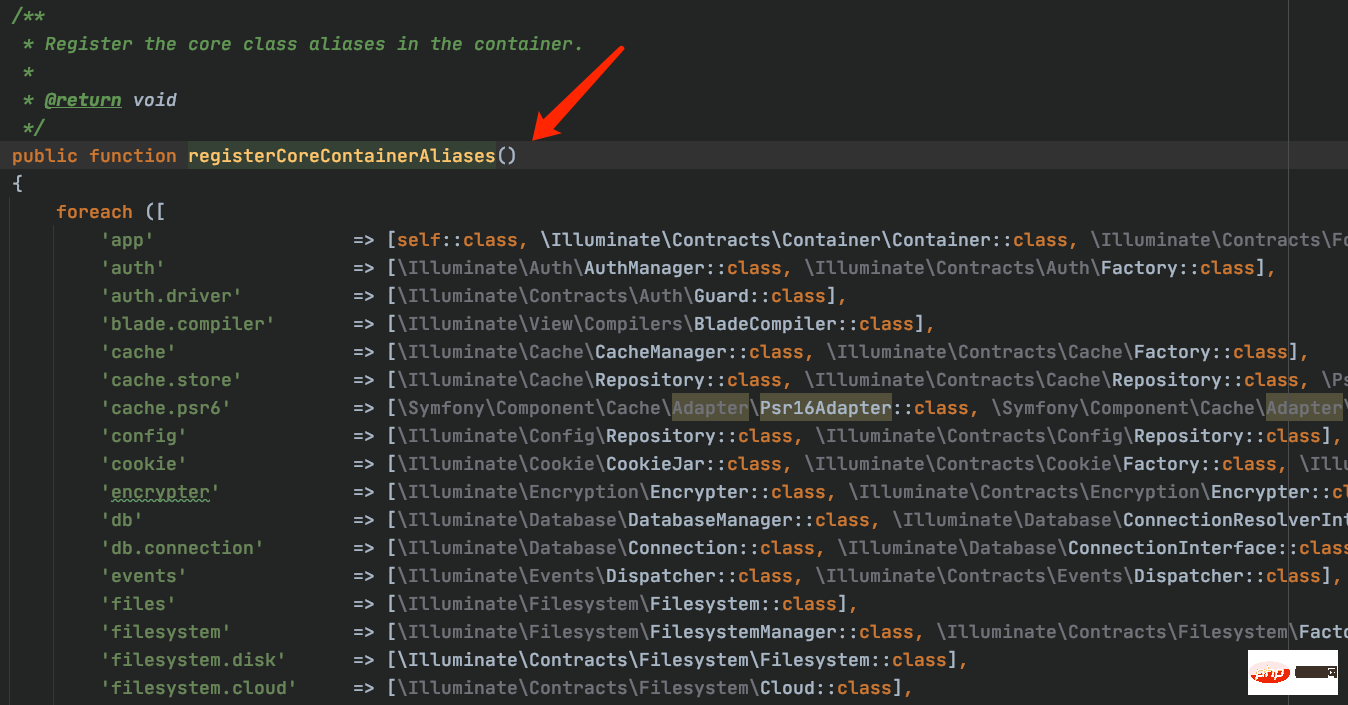ホームページ >PHPフレームワーク >Laravel >この記事を読めばLaravelの仕組みがしっかり理解できます!
この記事を読めばLaravelの仕組みがしっかり理解できます!
- 藏色散人転載
- 2020-12-23 09:12:134843ブラウズ
以下は、Laravel Framework チュートリアルコラムからの Laravel の動作原理の紹介です。
まえがき
知っていても、知っていても、このフレームワークに初めて触れたとき、ほとんどの人は実装方法がわからず混乱するはずです。 「確実な方法はありません。フレームワークの基礎知識があり、フレームワークのソースコードに直接アクセスすると、すぐに挫折してしまいます。Laravel フレームワークは非常に優れた PHP です。」フレームワークについては、この記事でしっかり理解できます フレームワークの動作原理は、面接での話(自慢)の材料になります 優れたフレームワークのソースコードを学び、研究することは、自社の技術向上にもつながります 次に、シートベルトを締めてください。経験豊富なドライバーが運転を始めます。 ! !
準備知識
- 一般的な配列メソッド、クロージャー関数の使用、マジック メソッドの使用など、PHP の基本的な知識を理解しておいてください。
- PHP のリフレクション メカニズムと依存関係の注入に精通している
- PHP 名前空間の概念と自動読み込みの構成に精通している
- 一般的なデザイン パターン (シングルトン モード、ファクトリなどを含む) に精通しているモード、ファサード モード、登録ツリー モード、デコレータ モードなど。
動作原理の概要
Laravel のエントリ ファイルFrameworkindex.php
1. 自動読み込みの導入 autoload.php file
2. アプリケーション インスタンスの作成と同時に完了
基本绑定($this、容器类Container等等)、 基本服务提供者的注册(Event、log、routing)、 核心类别名的注册(比如db、auth、config、router等)
3. 開始Http リクエスト処理
make 方法从容器中解析指定的值为实际的类,比如 $app->make(Illuminate\Contracts\Http\Kernel::class); 解析出来 App\Http\Kernel handle 方法对 http 请求进行处理 实际上是 handle 中 sendRequestThroughRouter 处理 http 的请求 首先,将 request 绑定到共享实例 然后执行 bootstarp 方法,运行给定的引导类数组 $bootstrappers,这里是重点,包括了加载配置文件、环境变量、服务提供者、门面、异常处理、引导提供者等 之后,进入管道模式,经过中间件的处理过滤后,再进行用户请求的分发 在请求分发时,首先,查找与给定请求匹配的路由,然后执行 runRoute 方法,实际处理请求的时候 runRoute 中的 runRouteWithinStack 最后,经过 runRouteWithinStack 中的 run 方法,将请求分配到实际的控制器中,执行闭包或者方法,并得到响应结果
4. 処理結果を返す
詳細なソースコード解析
1. 自動ロード クラスを登録し、ファイルの自動ロードを実装します。
require __DIR__.'/../vendor/autoload.php';
2. アプリケーション コンテナ インスタンス Application を作成します (このインスタンスはコンテナ クラス Container を継承します) )、コア (Web、コマンド ライン、例外) をバインドして、必要なときに解析しやすくします。
$app = require_once __DIR__.'/../bootstrap/app.php';
app.php ファイルは次のとおりです:
<?php // 创建Laravel实例 【3】 $app = new Illuminate\Foundation\Application( $_ENV['APP_BASE_PATH'] ?? dirname(__DIR__) ); // 绑定Web端kernel $app->singleton( Illuminate\Contracts\Http\Kernel::class, App\Http\Kernel::class); // 绑定命令行kernel $app->singleton( Illuminate\Contracts\Console\Kernel::class, App\Console\Kernel::class); // 绑定异常处理 $app->singleton( Illuminate\Contracts\Debug\ExceptionHandler::class, App\Exceptions\Handler::class); // 返回应用实例 return $app;
3. コンストラクターでアプリケーション インスタンス (Application.php) を作成するときに、基本バインディングをコンテナーに登録し、すべての基本サービス プロバイダーを登録し、コンテナーにコア カテゴリ名を登録します。
/**
* Register the basic bindings into the container.
*
* @return void
*/
protected function registerBaseBindings()
{
static::setInstance($this);
$this->instance('app', $this);
$this->instance(Container::class, $this);
$this->singleton(Mix::class);
$this->instance(PackageManifest::class, new PackageManifest(
new Filesystem, $this->basePath(), $this->getCachedPackagesPath()
));
# 注:instance方法为将...注册为共享实例,singleton方法为将...注册为共享绑定
}3.2. すべての基本サービス プロバイダー (イベント、ログ、ルーティング) を登録しますprotected function registerBaseServiceProviders()
{
$this->register(new EventServiceProvider($this));
$this->register(new LogServiceProvider($this));
$this->register(new RoutingServiceProvider($this));
}3.3. コア カテゴリ名をコンテナ
 #4. 上記により、クラスの自動ロード、サービスプロバイダーの登録、コアクラスのバインド、および基本登録のバインドが完了します
#4. 上記により、クラスの自動ロード、サービスプロバイダーの登録、コアクラスのバインド、および基本登録のバインドが完了します
5. 開始
http <pre class="brush:php;toolbar:false">index.php
//5.1
$kernel = $app->make(Illuminate\Contracts\Http\Kernel::class);
//5.2
$response = $kernel->handle(
$request = Illuminate\Http\Request::capture());</pre>5.1 のリクエストを解析します。make メソッドは、コンテナ
$kernel = $app->make(Illuminate\Contracts\Http\Kernel::class); 中的Illuminate\Contracts\Http\Kernel::class 是在index.php 中的$app = require_once __DIR__.'/../bootstrap/app.php';这里面进行绑定的,实际指向的就是App\Http\Kernel::class这个类
5.2 から指定された値を解析します。ここで http リクエストが処理されます
$response = $kernel->handle( $request = Illuminate\Http\Request::capture());
Enter
$kernel 表現されたクラス App\Http\Kernel.php では、一部のミドルウェア関連コンテンツのみが定義されており、handle メソッドがないことがわかります。 その親に行きましょうクラス
; でハンドル メソッドを見つけます。ハンドル メソッドがこのようなものであることがわかります<pre class="brush:php;toolbar:false">public function handle($request){
try {
$request->enableHttpMethodParameterOverride();
// 最核心的处理http请求的地方【6】
$response = $this->sendRequestThroughRouter($request);
} catch (Exception $e) {
$this->reportException($e);
$response = $this->renderException($request, $e);
} catch (Throwable $e) {
$this->reportException($e = new FatalThrowableError($e));
$response = $this->renderException($request, $e);
}
$this->app['events']->dispatch(
new Events\RequestHandled($request, $response)
);
return $response;}</pre>6.
リクエストを処理します (request を共有インスタンスにバインドし、パイプライン モードを使用してユーザー リクエストを処理します) <pre class="brush:php;toolbar:false">vendor/laravel/framework/src/Illuminate/Foundation/Http/Kernel.php的handle方法// 最核心的处理http请求的地方$response = $this->sendRequestThroughRouter($request);protected function sendRequestThroughRouter($request){
// 将请求$request绑定到共享实例
$this->app->instance('request', $request);
// 将请求request从已解析的门面实例中清除(因为已经绑定到共享实例中了,没必要再浪费资源了)
Facade::clearResolvedInstance('request');
// 引导应用程序进行HTTP请求
$this->bootstrap();【7、8】 // 进入管道模式,经过中间件,然后处理用户的请求【9、10】
return (new Pipeline($this->app))
->send($request)
->through($this->app->shouldSkipMiddleware() ? [] : $this->middleware)
->then($this->dispatchToRouter());}</pre>7.
メソッド、指定されたブートストラップ クラス配列を実行します$bootstrappers、構成ファイル、環境変数、サービス プロバイダー、ファサード、例外処理、ブート プロバイダーを読み込みます。非常に重要な手順で、vendor/ にあります。 laravel/framework/src/Illuminate/Foundation/ Http/Kernel.php<pre class="brush:php;toolbar:false">/**
* Bootstrap the application for HTTP requests.
*
* @return void
*/public function bootstrap(){
if (! $this->app->hasBeenBootstrapped()) {
$this->app->bootstrapWith($this->bootstrappers());
}}</pre>
<pre class="brush:php;toolbar:false">/**
* 运行给定的引导类数组
*
* @param string[] $bootstrappers
* @return void
*/public function bootstrapWith(array $bootstrappers){
$this->hasBeenBootstrapped = true;
foreach ($bootstrappers as $bootstrapper) {
$this['events']->dispatch('bootstrapping: '.$bootstrapper, [$this]);
$this->make($bootstrapper)->bootstrap($this);
$this['events']->dispatch('bootstrapped: '.$bootstrapper, [$this]);
}}/**
* Get the bootstrap classes for the application.
*
* @return array
*/protected function bootstrappers(){
return $this->bootstrappers;}/**
* 应用程序的引导类
*
* @var array
*/protected $bootstrappers = [
// 加载环境变量
\Illuminate\Foundation\Bootstrap\LoadEnvironmentVariables::class,
// 加载config配置文件【重点】
\Illuminate\Foundation\Bootstrap\LoadConfiguration::class,
// 加载异常处理
\Illuminate\Foundation\Bootstrap\HandleExceptions::class,
// 加载门面注册
\Illuminate\Foundation\Bootstrap\RegisterFacades::class,
// 加载在config/app.php中的providers数组里所定义的服务【8 重点】
\Illuminate\Foundation\Bootstrap\RegisterProviders::class,
// 记载引导提供者
\Illuminate\Foundation\Bootstrap\BootProviders::class,];</pre>8. # の
配列で定義されたサービス <pre class="brush:php;toolbar:false">Illuminate\Auth\AuthServiceProvider::class,Illuminate\Broadcasting\BroadcastServiceProvider::class,....../**
* 自己添加的服务提供者 */\App\Providers\HelperServiceProvider::class,</pre> をロードします##config/app.php 一般的に使用される Redis、セッション、キュー、認証、データベース、Route
9。パイプライン モードでユーザー リクエストを処理するには、最初にミドルウェア プロセスとフィルター
return (new Pipeline($this->app)) ->send($request) // 如果没有为程序禁用中间件,则加载中间件(位置在app/Http/Kernel.php的$middleware属性) ->through($this->app->shouldSkipMiddleware() ? [] : $this->middleware) ->then($this->dispatchToRouter());}app/Http/Kernel.php
/** * 应用程序的全局HTTP中间件 * * These middleware are run during every request to your application. * * @var array */protected $middleware = [ \App\Http\Middleware\TrustProxies::class, \App\Http\Middleware\CheckForMaintenanceMode::class, \Illuminate\Foundation\Http\Middleware\ValidatePostSize::class, \App\Http\Middleware\TrimStrings::class, \Illuminate\Foundation\Http\Middleware\ConvertEmptyStringsToNull::class,];10 を通過します。ミドルウェア処理後、リクエストの配布 (一致するルートの検索を含む)
/**
* 10.1 通过中间件/路由器发送给定的请求
*
* @param \Illuminate\Http\Request $request
* @return \Illuminate\Http\Response
*/
protected function sendRequestThroughRouter($request){
...
return (new Pipeline($this->app))
...
// 进行请求分发
->then($this->dispatchToRouter());}
/**
* 10.2 获取路由调度程序回调
*
* @return \Closure
*/protected function dispatchToRouter(){
return function ($request) {
$this->app->instance('request', $request);
// 将请求发送到应用程序
return $this->router->dispatch($request);
};}
/**
* 10.3 将请求发送到应用程序
*
* @param \Illuminate\Http\Request $request
* @return \Illuminate\Http\Response|\Illuminate\Http\JsonResponse
*/
public function dispatch(Request $request){
$this->currentRequest = $request;
return $this->dispatchToRoute($request);}
/**
* 10.4 将请求分派到路由并返回响应【重点在runRoute方法】
*
* @param \Illuminate\Http\Request $request
* @return \Illuminate\Http\Response|\Illuminate\Http\JsonResponse
*/public function dispatchToRoute(Request $request){
return $this->runRoute($request, $this->findRoute($request));}
/**
* 10.5 查找与给定请求匹配的路由
*
* @param \Illuminate\Http\Request $request
* @return \Illuminate\Routing\Route
*/protected function findRoute($request){
$this->current = $route = $this->routes->match($request);
$this->container->instance(Route::class, $route);
return $route;}
/**
* 10.6 查找与给定请求匹配的第一条路由
*
* @param \Illuminate\Http\Request $request
* @return \Illuminate\Routing\Route
*
* @throws \Symfony\Component\HttpKernel\Exception\NotFoundHttpException
*/public function match(Request $request){
// 获取用户的请求类型(get、post、delete、put),然后根据请求类型选择对应的路由
$routes = $this->get($request->getMethod());
// 匹配路由
$route = $this->matchAgainstRoutes($routes, $request);
if (! is_null($route)) {
return $route->bind($request);
}
$others = $this->checkForAlternateVerbs($request);
if (count($others) > 0) {
return $this->getRouteForMethods($request, $others);
}
throw new NotFoundHttpException;}これまでに、リクエストに一致するルートが見つかり、後で実行されます。これは、10.4
/**
* 10.7 返回给定路线的响应
*
* @param \Illuminate\Http\Request $request
* @param \Illuminate\Routing\Route $route
* @return \Illuminate\Http\Response|\Illuminate\Http\JsonResponse
*/protected function runRoute(Request $request, Route $route){
$request->setRouteResolver(function () use ($route) {
return $route;
});
$this->events->dispatch(new Events\RouteMatched($route, $request));
return $this->prepareResponse($request,
$this->runRouteWithinStack($route, $request)
);}
/**
* Run the given route within a Stack "onion" instance.
* 10.8 在栈中运行路由,先检查有没有控制器中间件,如果有先运行控制器中间件
*
* @param \Illuminate\Routing\Route $route
* @param \Illuminate\Http\Request $request
* @return mixed
*/protected function runRouteWithinStack(Route $route, Request $request){
$shouldSkipMiddleware = $this->container->bound('middleware.disable') &&
$this->container->make('middleware.disable') === true;
$middleware = $shouldSkipMiddleware ? [] : $this->gatherRouteMiddleware($route);
return (new Pipeline($this->container))
->send($request)
->through($middleware)
->then(function ($request) use ($route) {
return $this->prepareResponse(
$request, $route->run()
);
});}
/**
* Run the route action and return the response.
* 10.9 最后一步,运行控制器的方法,处理数据
* @return mixed
*/
public function run()
{
$this->container = $this->container ?: new Container;
try {
if ($this->isControllerAction()) {
return $this->runController();
}
return $this->runCallable();
} catch (HttpResponseException $e) {
return $e->getResponse();
}
}11 の runRoute メソッドです。ルートを実行して、応答を返します (強調)ご覧のとおり、10.7 の 1 つのメソッドは
prepareResponse です。これは、指定された値から応答インスタンスを作成し、
runRouteWithinStack メソッドはスタック内のルートを実行します。つまり、 http リクエストとレスポンスの両方がここで完了します。
概要
これまでのところ、Laravel フレームワークの実行プロセス全体が分析され、Laravel フレームワークの謎が明らかになりました。 Veil 氏が明らかにしました、記事を読みやすくするため、コアコードのみを記載しています。ソースコードは記事と合わせて自分で読む必要があります。記事に記載されている予備知識を理解する必要があることに注意してください。これはフレームワークのソース コードを読むための前提と基礎です。皆さんも何かを学んで車から降りていただければ幸いです。 ! !
以上がこの記事を読めばLaravelの仕組みがしっかり理解できます!の詳細内容です。詳細については、PHP 中国語 Web サイトの他の関連記事を参照してください。

